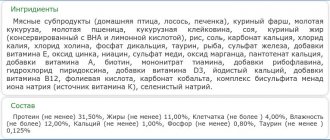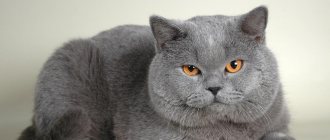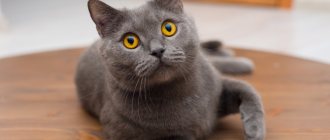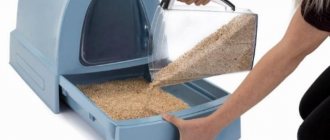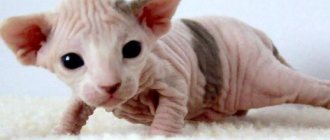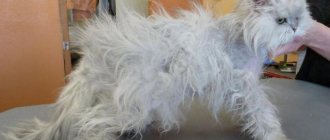What will you learn from the article?
- Why care for your cat's fur?
- How to comb a cat Tools for combing cats
- Massage tools
- Special tools
- Combing rules
Why do you need to care for cat fur, how to comb it, what grooming tools to use at home - look for answers to all these questions about caring for cat fur in our article.
Cat brushing tools
An important question is how to choose a brush. Animal hair has a different structure from human hair, so you cannot use regular combs. There are a lot of brushes in the pet store; they differ not only in appearance, but also in purpose.
Slicker comb: the most popular
A slicker brush, or slicker, is a brush with metal teeth. They can be straight or slightly curved and have different lengths. Hence the choice:
- for thick, long hair you need to choose a slicker with long, frequent teeth;
- For a short-haired cat, a brush with sparser and shorter teeth is suitable.
You can use a slicker only after the wool has been combed with a wide-toothed comb; do not use it if there are tangles.
During shedding, it is not recommended to use the slicker daily: twice a week is enough.
Mitten: the easiest to use
If your pet actively resists and does not want to be combed with combs and brushes, you can use a special rubber mitten. On its surface there are teeth of different lengths and frequencies.
After placing the cat on your lap, you can gently stroke it with your gloved hand. This is a good massage for the skin, which improves blood circulation and strengthens hair follicles. The pet's fur becomes shiny. The mitten is especially convenient for short-haired cats.
Furminators
When shedding, it is convenient to use a furminator - a rectangular comb with teeth that has a rubberized handle. This device, which resembles a small rake, is convenient for massage and untangling small tangles.
The comb can be of different sizes, depending on the age and size of the cat. For kittens, a furminator 3 cm wide is sufficient; adult animals need to choose wider ones – from 4 cm.
Brushes
Natural bristle brushes are suitable for brushing your cat. Their advantage is that the hairs are not electrified; cats really don’t like it when this happens, and in the future they may refuse to comb them.
A convenient device is a double-sided brush. It has bristles on one side and rounded metal teeth on the other. She can not only comb the cat, but also give a gentle massage.
Crest
Owners often choose a comb to comb their pets. This fine-toothed comb is convenient to use when shedding or when you need to rid your pet of fleas. The frequent teeth pick up living and dead parasites when it is not possible to wash them out of long hair with water.
How to brush a cat
A comb for combing cats should be in every home. But why is it important to brush your pets regularly? There is an explanation for this:
- when brushing smooth-haired and long-haired cats, the amount of hair in the apartment that the animals leave behind when lying on the bed or playing on the floor is significantly reduced;
- Constant combing of hair helps to get rid of tangles and also prevent their appearance on the body;
- after using the slicker, the coat becomes smoother and more well-groomed, and the skin becomes well-groomed and healthy;
- If brushing of smooth-haired cats occurs too rarely or is absent altogether, the animal will have to comb out dead skin particles on its own, and the accumulation of hair in the stomach will cause it to accumulate - as a result, the cat may die due to digestive problems or from intestinal obstruction.
Special devices for combing out the undercoat can be found at any pet store. However, before buying it, it is important to select the device correctly.
Today, there are several types of combs for combing cats:
- anti-matt device;
- comb with rotating teeth for cats;
- puffers;
- scratcher;
- flea brush for cats;
- comb glove;
- comb with blade.
It is known that cats react to the sound of a comb, and they also have an “inappropriate reaction” to this device. Therefore, it is important to choose the right animal hair tool that is suitable for your pet and will not cause him discomfort. After all, if caring for a cat brings joy and benefits to its health, it will get used to such a procedure and will not run away at the sight of a comb.
We suggest you read: What to feed your Shih Tzu
When you start scratching a cat, you not only take care of its fur, but also get additional positive emotions from its mood. After all, this is at the same time a useful massage for the skin, which gives it the opportunity to breathe better. And also, a way to remove foreign irritants that have become embedded in the animal’s fur.
The most obvious benefit of this procedure for the owner himself is the well-groomed appearance of his cat, which is pleasant to look at. And of course in the condition of the apartment, because there is much less hair and dust.
Do you already know what kind of fur cats have and what it consists of? It is structured very simply:
- Awn: This is long cone-shaped hair. They protect the cat's skin from injury and retain heat.
- Undercoat: This is short and fine hair. As a rule, they serve to preserve heat in the animal’s body and prevent it from freezing during the cold season. It is in the cold that active growth of undercoat hair, which is also called down hair, is expected.
- Whiskers and sensitive hairs: Whiskers, eyebrows, hairs located above the upper lip - thanks to them, cats have a pronounced sense of touch, which helps to analyze the environment. Also, they are on the tail and paw pads, it is due to them that pets easily hunt for moving prey.
You should start caring for your cat's fur from the time he was a kitten. This is necessary so that the pet gets used to combing and does not worry, perceiving it as a form of communication with the owner.
But even an adult cat can be easily accustomed to this. Just stroke her with your hand along the entire length of the fur and strictly along the fur, in no case against it. And after that you can pick up the scratcher.
There are several types of objects that can be used to brush your pet.
- Brushes. They come in rubber and steel. Their teeth have a rounded appearance.
- Combs. Made from metal, plastic or wood. In appearance they differ in frequent and rare parting between the teeth.
- Terry cloth can be used perfectly for laying pile on a cat's fur coat. If there is no fabric, you can replace it with damp suede.
- Special gloves with roughness intended for massage.
Take a sparse comb in your hands and start combing the cat. After that, use frequently. A brush made of bristles perfectly removes static from your pet’s fur and gives the fur shine. It is necessary to complete the combing procedure with a brush made of rubber. It perfectly collects lost hairs.
To start brushing your cat you need to be patient. This should be done gradually. Preferably when she is resting, for example, during sleep. You need to start scratching where she likes and feels good. It is best to groom the coat daily, namely before feeding, so that the cat gets used to the comb, hands and movements.
Try to communicate with her and praise her. After this procedure, reward her with delicious food. During combing, the fallen hairs are removed, and they will no longer fall into the ventricle.
To care for the coat when combing you will need:
- comb with the rarest teeth;
- comb or rubber brush;
- combs with sparse teeth;
- flea removal combs.
Brushes and combs made from artificial hair are not used, as they contribute to the appearance of static electricity and can cause hair breakage.
Mitten: the easiest to use
If your pet doesn't like combs and slickers, try using another tool popular among cat owners - a rubber mitten.
We invite you to familiarize yourself with: American Shorthair cat (45 photos): an attractive breed with a history
Short or long teeth, located at different frequencies on the surface of the mitten, perfectly massage the skin of the animal. Thanks to this, blood circulation improves, the hair follicles are strengthened, and the coat becomes healthy and shiny. Cats love this massage very much. It can be carried out both on dry wool and during water procedures.
Mr. Cat recommends: How often should you brush your cat?
It is enough to brush cats twice a week, but with intense shedding, this should be done daily, before feeding.
For the winter, British cats “stock up” with dense undercoat, which can become tangled, so in winter you need to comb your pet at least 2 times a week, using a slicker with thick, thin teeth that have metal attachments. You need to act carefully: a regular slicker brush can ruin the undercoat.
Why are tangles dangerous?
if you ignore the formation of tangles, this can affect the health of your pet
Mats spoil the appearance of your pet. They make the cat look untidy. Professional breeders can ruin their reputation if a purebred cat looks unkempt. And even if the pet is a simple domestic cat, but with tangles, it will be unpleasant to stroke it. However, in addition to not being aesthetically pleasing, pets with mats are at risk of diseases:
- germs and parasites;
- dermatological problems;
- the cat may damage its skin.
Mats can form from wool that is wet (with saliva), and in the form of a lump, the wool will not be able to dry at all. This saliva can harbor parasites and germs. Their activity on the animal's skin can lead to dermatological problems. And the same problems can arise without exposure to parasites. The skin under the mat will become hot and overheat. Experiencing severe itching and discomfort, the cat will try to scratch its skin and remove mats. This way, the cat can damage its skin with its claws and teeth, and the resulting scratches can become infected.
Why does a cat shed?
Many people who have never owned this animal have a question: why brush a cat, since stray cats do an excellent job of doing this on their own. In fact, any animal sheds, it’s just that “vagrants” live in the fresh air, and seasonal climate changes help strengthen their coat. Probably, many of us have noted that healthy indoor cats have beautiful fluffiness.
Animals that live permanently in an apartment often suffer from a lack of vitamins; their coats and skin dry out in the winter due to the influence of heating devices, and in the summer due to air conditioners. Domestic cats shed much more intensely than indoor cats all year round, and seasonal shedding generally turns into real hair loss.
Another factor that affects the amount of hair shed is the breed of the animal. Domestic cats are mostly purebred animals, artificially bred by humans for the sake of their beautiful fur coat, so the fluffier the animal, the more attention it will have to be given.
Contraindications
Even such an important and necessary procedure for a cat’s health may have contraindications.
You cannot use a furminator to comb animals if their fur does not have undercoat or has a special appearance, these include:
- Cornish Rex;
- Devon Rex;
- Turkish Angora;
- Burmese and Singapore cats;
- orientals.
In addition, it is prohibited to use combs and brushes with metal teeth, which can further damage the animal’s skin, which has scratches, scratches and abrasions, irritations and ulcers.
If there are tangles, they should be disassembled carefully. In particularly advanced cases, it is better to contact a groomer who will do it professionally.
Caring for the coat during shedding
The real test for the owner begins when the animal sheds, when it is necessary to comb the cat's fur and thereby help it. During this period, a short-haired cat needs to be brushed every 3 days, a fluffy cat almost every day.
You can effectively remove hair by combing it against the direction of hair growth. When choosing what to comb your cat with, in the initial stages you should give preference to brushes with sparse teeth. Over time, you should gradually switch to combs with tighter teeth.
You need to finish the combing procedure in this way: moisten your hand with water and rub the cat’s skin several times (against hair growth). This is an effective way to remove dead fur.
A kitten should be accustomed to brushing at home from the first molt, which occurs at the age of 5-7 months.
Reasons for the formation of mats in cats
A mat is a dense lump of matted wool. Long-haired cats are more likely to develop mats. Mats are formed from undercoat hairs (thin, short, almost “downy” hairs) that were not removed in time.
Persian cats are prone to matting
If such lumps have formed in a short-haired cat, then there is a possibility that the cat is seriously ill. In this case, you need to urgently contact a veterinarian. But in cats with long hair, tangles can appear for several reasons:
- oral diseases;
- dermatological problems;
- the appearance of skin parasites;
- wool contamination;
- incorrect selection of food products;
- improper care, etc.
Active young cats can look after themselves. If tangles have formed, then the cat cannot cope on its own. Most often this happens because the animal is suffering (for example, if the cat has an oral or skin disease). After all, licking fur on flaky and cracking skin can be painful. In cases where the pet has skin parasites (lice, fleas, lice eaters, etc.), the animal has to lick itself more often. Wool that does not have time to dry falls into clumps. In addition, the reason for the formation of tangles may lie in the wool itself. So it may be contaminated with a substance that is difficult to wash off.
Imagine a situation where chewing gum or plasticine got into your hair. The hair gets tangled, stuck together, and trying to clean out the Velcro is very painful. In cats, such “sticking” can occur due to oil or glue getting into the fur, for example.
In addition, the coat can become brittle and brittle due to poor nutrition (for example, lack of vitamins). This is how the split ends of the undercoat become tangled and turn into tangles. And finally, the main reason for the formation of lumps is improper care of the cat’s hair. Cats should not be washed with shampoos intended for humans. Sometimes after washing a pet (even with cat shampoo), the owner rushes to dry the cat as quickly as possible. Improper drying of a cat after bathing also leads to matting of lint. The wool can be blotted with a soft towel rather than rubbed.
Teaching a cat to scratch
The whip method is definitely inappropriate here. Screaming, hitting, or tying paws is strictly forbidden. You don’t want your pet to experience enormous stress after each brushing procedure, do you? If the cat categorically refuses the procedure, it may be due to the wrong instrument. Perhaps he is causing pain to the cat or you are making sudden movements.
Follow the instructions to make friends with a cat and a comb:
- First, show the animal the device. Let him smell it and examine it from all sides. This way your pet will understand that the tool is safe.
- Be consistent. Decide what time you will brush your cat every day. He must get used to the procedure and perceive it as a daily necessity.
- To make the animal feel good, start brushing with light stroking of the cheeks, chin, and head. Purrs love having these areas massaged. Gradually move on to the remaining areas.
- Never press the brush with force, even if you need to untangle hairs or reach hard-to-reach places.
- After each procedure, do not forget to praise your pet and treat it.
The main thing is consistency and gentleness. Do not force the animal, comb it at the same time, and not when you remember it. And, of course, the sooner you start brushing your cat, the faster he will get used to it and will not run away from you.
Types of wool
Different breeds of cats have different lengths and thicknesses of fur, which means that they will need to be cared for differently. If your pet has short hairs, then the procedure is practically not required; you can use a mitten.
To answer the question of how to comb a long-haired cat, you should first familiarize yourself with how to do it correctly. The procedure will take a lot of time and needs to be done frequently. The same rule applies to cats with semi-long hair. If your pet has an undercoat, then it must be combed with special care.
When not to comb
Combing the fur is very important to keep your pet healthy. However, there are situations when you should not use a furminator, and it is better to give preference to the most gentle options. You cannot use such a device if you have the following problems:
- skin diseases or irritations on the integument;
- presence of scratches or abrasions.
You should be very careful with existing tangles; combing is done carefully so as not to cause pain to your pet. It is prohibited to use a Furminator if the cat does not have undercoat or is a curly breed.
Frequency of use and benefits of products
This event is recommended to be carried out once or twice a month for British cat breeds. In summer, using a furminator will carefully remove excess undercoat. It is also necessary to comb out during the molting period - the beginning of spring and autumn - two to three times a week. Advantages of Furminators for a Briton:
With this device you don’t have to resort to cutting the animal.
- Reducing the amount of hair falling out, minimizing mats and mats.
- Savings on visits to grooming salons.
- Due to the correct distribution of fatty lubricant, the appearance of the animal's fur coat is significantly improved - it becomes beautiful and shiny.
- Easier cleaning due to reduced amount of hair loss.
Thus, each cat owner himself chooses what is best for a furry animal - a comb for a British cat, a brush-mitten, or simply removing hair with a damp cloth - after all, the main thing is that the care is correct. That’s why it’s so important to carefully care for your pet’s fur coat - he, in turn, will not remain in debt and will repay you with love for your care.
How to groom an animal
When caring for your purr's fur coat, it is worth considering several rules so that the cat and the comb become inseparable comrades.
Follow the instructions below to ensure the best possible care.
Inspect your pet's body for wounds and scratches. If any of this is present, abandon the procedure for a while or carefully comb the fur coat with a wide-tooth comb, avoiding the damaged area of the skin.
Look at the condition of the coat. If there are tangled areas somewhere, then it is easier to carefully cut them off with scissors or a tangle cutter than to try to untangle them and thereby cause pain to the four-legged animal.
If there are no wounds or tangled places on the cat’s body, then you can start combing. Do not immediately start with a comb that has frequent and fine teeth - first use a wide comb. You should first moisten the device with water so that the hairs stick to it and do not fly around the room.
Start combing the animal from the tail, gradually moving towards the head. The hard short fur and soft undercoat are combed against growth. But if your pet has long fur, then you need to comb it only in the direction of hair growth. Do not press the tool too hard - this may be painful for the cat.
Special attention is paid to the panties and belly, as the fur there is softer and easier to tangle. It is better to scratch these areas when the cat is lying on his back. If the pet resists, ask someone in the household to hold it, but do not use brute force so that the pet does not become stressed.
Finish the procedure with a natural wool brush or massager. This will make your fluffy happy and will collect the remaining dead hairs.
After all the manipulations, be sure to pet your pet and treat him with something tasty. This will reinforce in his mind that brushing is a pleasant activity. And if it’s unpleasant, then you can endure it a little - but then there will be a well-deserved reward.
Treatment frequency
There is no clear answer to the question of how often you should brush your pet - it all depends on the breed. If she is short-haired, then once a week is enough. Long-haired cats require more attention: it is advisable to brush them every day. But if you don’t have time for this, then 2-3 times a week will be enough.
Regularity of the procedure
The cat licks itself several times a day. If you do not comb your pet, very serious consequences can occur. While licking itself, the animal swallows a lot of hairs. They enter the digestive tract, and then the cat often vomits hairballs. An even more serious problem will arise if the intestines become clogged with accumulated hair. This may cause intestinal obstruction and require surgery.
Another problem for cat owners is tangles in which hairs get stuck. Long-haired pets especially often suffer from this.
For your information! Only an experienced specialist should cut tangles, because this procedure requires accuracy and skill.
Grooming your cats will help keep your home clean. There will be much less wool left on bedspreads, carpets and chairs, and you won’t have to clean the apartment too often. Obviously, only very irresponsible owners do not know how to brush a cat and why it should be done.
A thick undercoat helps the body retain more heat. Happy owners of long hair and a thick undercoat need constant brushing. Such animals need to be combed daily. For short-haired dogs, once a week is sufficient.
If an animal tears hair
Combing is one of the measures to prevent your pet from licking its own fur and thereby clogging its stomach. If this happens, then the body gets rid of the lump in a logical way - by vomiting.
Everything would be fine, but the presence of a large amount of hair in the gastrointestinal tract leads to a deterioration in the animal’s well-being, it becomes apathetic and loses its appetite. In the worst cases, a blockage occurs and the animal will have to undergo surgery.
To prevent this, it is important to comb your pet frequently, give special food and sprouted grass. But the best way to deal with gastrointestinal blockage is malt paste, which can be bought at any pet store.
Combs for the British
Every loving animal owner thinks about which comb to choose for his British cat. On the shelves of pet stores there is an incredible variety of such items that can be selected according to the individual preferences of the owner of the furry animal, for every taste and budget. There are different types of combs:
Such a device can be made in the form of a mitten.
- with Teflon coating;
- comb rake;
- with stainless steel teeth;
- with rotating teeth;
- comb with multi-level teeth;
- brush-mitten.
The length of the brush teeth is selected depending on the length of the pet’s coat; it is very convenient that this information is indicated on the product packaging. The hair of the British is quite short, so that all of the above combs can be used; caring for the delicate fur of this type of breed can be replaced by regular wiping with a wet hand. As a result of this procedure, much more hair is removed than with brushes. The British fur coat is the main advantage of a cat, which is why care should be as thorough and effective as possible.
Furminator and its types
This is a very popular miracle tool for combing the coat of a British cat, and the process does not cause discomfort to the animal, and more often, even the opposite. There are two types of furminators - classic type and deluxe. The only difference between these varieties is the presence of a FURejector button in the deluxe line for automatically removing hair from the comb. Each of them is designed separately for each type of cat - short-haired and long-haired.
Before brushing your cat with a furminator, you must comply with the following conditions:
- It is advisable to bathe the animal and dry the fur before the procedure.
- Do not use if there are lesions or wounds on the skin.
- Before the procedure, comb with a regular brush.
- Cut off all tangles using scissors.
- Start combing slowly according to hair growth. Particularly carefully comb the area of the abdomen and anus.
Return to contents
Brush selection
A brush for combing cat hair should be selected depending on the length and type of fur. A different set of brushes will be needed for long-haired and short-haired pets, as well as for their Scottish counterparts. Outbred cats can also be short-haired or long-haired. Their coat also needs good care.
Long-haired pets
Luxurious hair needs to be well looked after. A caring owner should pay especially much attention to combing long-haired and semi-long-haired cats. These breeds include Persians, Maine Coons, Kuril Bobtails, Turkish Angora, Neva Masquerade, Burmese, Siberian, Norwegian Forest and many other cats. For them you will need at least three combs with teeth of different lengths:
- with short and frequent;
- with averages;
- with long and sparse ones.
You need to carefully care for your furry pet's luxurious coat, so you also need to purchase an anti-tangle spray, conditioner, a brush with natural bristles, and talcum powder.
DIY haircut
Animals with thick fur need to be trimmed periodically, as hair clumps can sometimes form, causing some discomfort. It is not always possible to comb such areas, and taking the animal to the hairdresser will be expensive, so many people prefer to carry out the process themselves. Grooming cats at home should be carried out according to certain rules:
- First, you will need to shorten your pet’s claws a little, using a nail clipper.
- For the first time, it is better to invite a specialist who knows how to properly hold an animal to carry out the procedure, and it will be easier to deal with a four-legged friend. The cat lies on its side and holds on to its paws.
- Next, you should arm yourself with a clipper and carefully cut the wool. After the sides are finished, move on to the back and front. It is very important to act extremely carefully, since there are nipples on the stomach.
- In order not to injure your pet, it is better to cut off the lumps using scissors, since doing this with a clipper will be problematic, and the cat will become nervous.
- To avoid cutting the animal, it is necessary to stretch the creature's skin.
- At the end of the procedure, you will need to wash the cat using clean water, after which it is dried with a hairdryer.
If the animal is always at home, then haircut can be done at any time. However, this does not apply to pets that are occasionally outdoors. Such cats need to be clipped only before the summer season.
Some care tips
If you are interested in how to properly comb a cat, then you should know certain rules that you should follow. Thanks to them, caring for your pet will become much easier. Experts recommend sticking to some basics:
- To really help your pet, you should make brushing a regular procedure.
- The choice of comb must be made based on the characteristics of the coat.
- The process must be carried out based on the length and thickness of the hairs.
- Accustoming to manipulation is done at a young age, and it is better in a playful way.
- It is advisable to avoid the appearance of tangles, and if they form, remove them with great care.
- During the procedure, it is necessary to examine your pet in order to get rid of existing problems in a timely manner.
It is important that the cat is in a good mood; it should not break out during the brushing period. If the animal twitches and struggles, then a positive result cannot be expected. This can only lead to tufts of fur being pulled out or your pet's skin being damaged. In addition, the cat will remember this procedure for a long time, which means it will be afraid of it.
Why care for your cat's fur?
Regular brushing sessions clean the animal's fur of dirt and dander, remove dead hair, prevent the fibers from getting tangled and reduce the number of hairballs in the cat's stomach.
By combing the animal, you give it a massage. This improves blood circulation in the upper layers of the skin, which leads to improved coat quality. During the hot season, brushing helps prevent heatstroke.
Grooming helps keep your home clean while your pet is shedding. If you don't brush out a shedding cat, dead hairs will fly around the apartment, accumulating on the floor, carpeting, furniture and your clothes.


